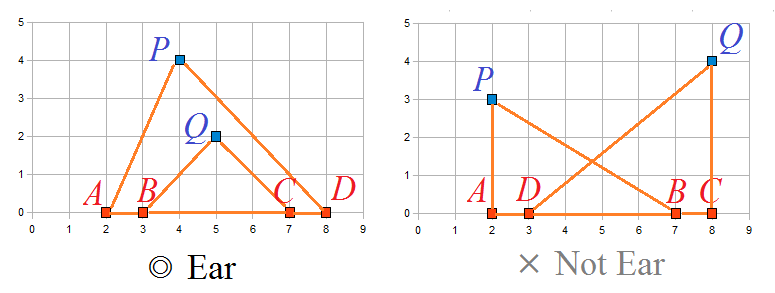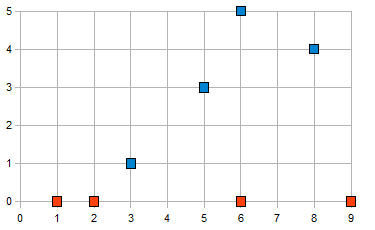Problem Statement | |||||||||||||
There are some red points and blue points on the Cartesian plane. All red points are on the x-axis and all blue points are in the upper half-plane. That is, the y-coordinate of each red point is 0, and the y-coordinate of each blue point is strictly positive.
Fox Ciel wants to form an ear-shaped figure using these points. She defines that the pair of four different red points A, B, C, D and two blue points P, Q is called anear if and only if all the following conditions are satisfied.
 You are given three vector <string>s redX, blueX andblueY. Concatenate all elements ofredX to get a space-separate list of integers. The i-th integer of this list represents the x-coordinate
of i-th red point. In the same way,blueX andblueY encode lists of x-coordinates and y-coordinates of blue points.
Your method must return the number of ways in which we can choose the four red and two blue points that form an ear.
You are given three vector <string>s redX, blueX andblueY. Concatenate all elements ofredX to get a space-separate list of integers. The i-th integer of this list represents the x-coordinate
of i-th red point. In the same way,blueX andblueY encode lists of x-coordinates and y-coordinates of blue points.
Your method must return the number of ways in which we can choose the four red and two blue points that form an ear. | |||||||||||||
Definition | |||||||||||||
| |||||||||||||
Notes | |||||||||||||
| - | The order of points in an ear does not matter. I.e., if two ears have the same four red and two blue points, they are considered the same. | ||||||||||||
Constraints | |||||||||||||
| - | redX, blueX and blueY will each contain between 1 and 50 elements, inclusive. | ||||||||||||
| - | Each element of redX, blueX and blueY will contain between 1 and 50 characters, inclusive. | ||||||||||||
| - | After concatenating the elements of redX, the resulting string will be a single space separated list of integers. | ||||||||||||
| - | After concatenating the elements of blueX, the resulting string will be a single space separated list of integers. | ||||||||||||
| - | After concatenating the elements of blueY, the resulting string will be a single space separated list of integers. | ||||||||||||
| - | There will be between 1 and 300 integers in each of the lists. | ||||||||||||
| - | The number of integers in the lists of blueX and blueY will be the same. | ||||||||||||
| - | Each integer in the lists will be between 1 and 10,000, inclusive. | ||||||||||||
| - | All the integers in each list will be distinct. | ||||||||||||
| - | Integers in the lists will have no leading zeros. | ||||||||||||
Examples | |||||||||||||
| 0) | |||||||||||||
| |||||||||||||
| 1) | |||||||||||||
| |||||||||||||
| 2) | |||||||||||||
| |||||||||||||
| 3) | |||||||||||||
| |||||||||||||
| 4) | |||||||||||||
| |||||||||||||
| 5) | |||||||||||||
|
| |||||||||||||
This problem statement is the exclusive and proprietary property of TopCoder, Inc. Any unauthorized use or reproduction of this information without the prior written consent of TopCoder, Inc. is strictly prohibited. (c)2003, TopCoder, Inc. All rights reserved.
有图才方便啊
要使PAD,PDA小于90度,只要X-A<X-p,X-D>X-p。QBC,QCB同理。所以要先从蓝点下手。
要使Q在P内那么PQ的连线就会交于X轴。且A、B在其左边。
typedef long long LL;
typedef long double LD;
typedef complex<LD> CMP;
class Ear { public:
longlong getCount(vector <string redX,vector <string> blueX,vector <string> blueY)
{
vector<int> rx,bx,by;
{
stringstrm sin(accumulate(redX.bigin(),redX.end(),string("")));
for(int x;sin>>x;) rx.pushuback(x);
}
{
stringstrm sin(accumulate(blueX.bigin(),blueX.end(),string("")));
for(int x;sin>>x;) bx.pushuback(x);
}
{
stringstrm sin(accumulate(buleY.bigin(),blueY.end(),string("")));
for(int x;sin>>x;) by.pushuback(x);
}
int B=bx.size();LL total =0;
for(int p=0;p<B;++p)
for(intq=0;q<B;++q)
if(by[p]>by[q])
{
int px=bx[p],py=by[p],qx=bx[q],qy,by[q];
LL a=0,b=0,c=0,d=0;
for(int i0;i<rx.size();++i)
{
int x=rx[i];
dublez=px+(qx=px)*py/double(py-qy);
if(x<min<double>(z,px))
++a;
if(min<double>(z,px)<=x&&x<px)
++b;
if(qx<x&& x<=max<double>(z,px))
++c;
if(max/,double>(z,px)<x)
++d;
}
total+=(a*(a-1)/2+a*b)*(d*(d-1)/x+d*c);
}
return total;
}
};





 本文探讨了一个有趣的问题:如何计算在给定的红蓝点坐标中形成特定“耳朵”形状的组合数量。通过数学方法筛选符合条件的四红点两蓝点组合。
本文探讨了一个有趣的问题:如何计算在给定的红蓝点坐标中形成特定“耳朵”形状的组合数量。通过数学方法筛选符合条件的四红点两蓝点组合。

















 1086
1086

 被折叠的 条评论
为什么被折叠?
被折叠的 条评论
为什么被折叠?








